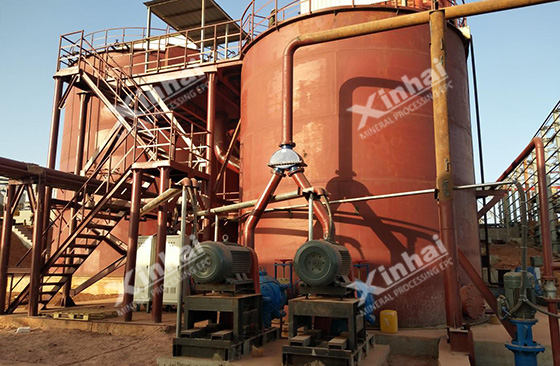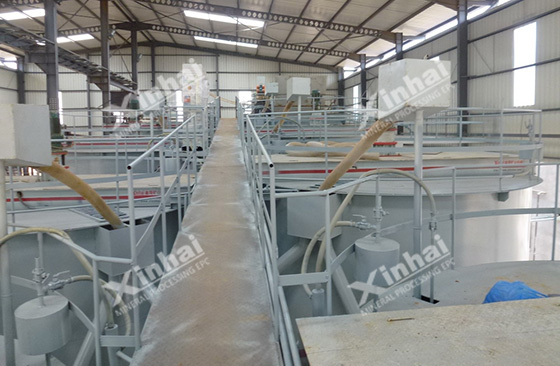
Refractory gold ore refers to the part of gold ore that cannot be extracted effectively by the conventional cyanide leaching process after the fine grinding. The gold in this type of gold ore cannot contact with the cyanide solution due to physical encapsulation or chemical combination, resulting in a very low gold leaching rate. Therefore, how can we improve the gold leaching effect of the refractory gold leaching process?
The gold leaching rate of most refractory gold ores is about 10% ~ 20% when they are directly stirred by sodium cyanide. Generally, the gold leaching rate of refractory gold ore can be greatly improved by pretreating the raw materials, including oxidative roasting, hot-pressure oxidation, biological oxidation.
1. Roasting
The roasting can resolve the sulfide, make the arsenic and antimony volatilize in an oxidized state, and make the carbonaceous materials lose the inactivity. The process has the advantages of strong adaptability, low operating cost and good comprehensive recovery effect. The disadvantage is that it is easy to cause overburn and underburn, and the generated SO2 and As2O3 will pollute the environment. The roasting methods commonly used before the gold leaching process include two-stage roasting, sulfur-fixing and arsenic-fixing roasting, and pellet coating roasting.
2. Hot-pressure oxidation
The hot-pressure oxidation method is divided into acid hot-pressure oxidation and alkaline hot-pressure oxidation. The alkaline hot-pressure oxidation is only suitable for refractory gold deposits with high carbonate content and low sulfide content (<20%). The acidic hot-pressure oxidation means that the pyrite, arsenopyrite and other sulfides react with the oxygen in an acidic medium under the high temperature and high pressure. After the mineral structure changes, the wrapped gold is exposed, which is conducive to the effect of the gold leaching process.
The hot-pressure oxidation process is a wet process without smoke pollution. The oxidation products of pyrite and arsenopyrite are soluble, so the gold particles can be dissociated regardless of size, and the recovery rate of gold is relatively high. The gold leaching rate of much refractory gold concentrate is as high as 98% after the hot-pressure leaching.
3. Biological oxidation
The basic principle of the biological oxidation is that the metal sulfide minerals are resolved through the action of biological enzymes, so the gold ores are dissociated. The biological oxidation is generally divided into slot oxidation and heap oxidation. This process will not produce harmful gases, such as SO2 and As2O3, has less investment, low cost and easy to operate.
The experimental results show that the gold leaching rate of a gold concentrate with high sulfur and arsenic can be increased from 15.02% to 94.17% through the bacterial oxidation cyanidation process.

1. Multi-stage leaching
Multi-stage leaching means that the solution saturated with impurity ions is extracted after each stage of leaching, and then cyanide leaching is carried out again by adding water or a solution with fewer impurity ions. The number of leaching stages depends on the leaching index. The process is mainly used to treat refractory gold ores containing cyanide soluble impurities.
2. Carbon in leaching (CIL)
Carbon in leaching (CIL) refers to the cyanide leaching of gold and the adsorption of ions on activated carbon is completed simultaneously in the same tank. During the gold cyanide leaching, add an excess activated carbon in the leaching solution to make it and carbonaceous material to carry out competing adsorption, which can reduce or eliminate the harmful effects of carbonaceous material, so this process is suitable for the treatment of refractory gold ores which contain the material can adsorb the gold.
3. Pressure cyanide
Pressure cyanidation is a dynamics method to enhance the gold leaching process. Increasing the reaction temperature and activating the mineral lattice is beneficial to the gold leaching process. This process is particularly suitable for the treatment of refractory gold ores containing antimony.
4. Agitation strengthening
Agitation strengthening is to strengthen the gold leaching process and improve the gold leaching rate by changing agitation conditions. The commonly used agitation methods are intense agitation, oscillation agitation, pulse agitation and so on. The experimental results show that the gold leaching rate of certain gold ore can be increased from 73.45% to 90.5% by using the oscillating agitation method.

Among the above refractory gold leaching processes, pretreatment is the most commonly used method at present. Strengthening leaching has a good effect on the treatment of some medium refractory gold ores.
To find out more about our products and solutions, please fill out the form below and one of our experts will get back to you shortly.